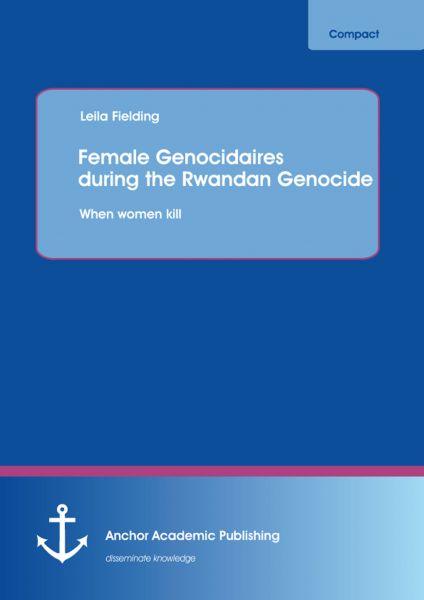Female Genocidaires during the Rwandan Genocide: When women kill
Victimisation of women in times of war, genocide or mass slaughter has been the primary focus of the majority of explorations concerning gender and conflict. Traditionally, women are espoused as victims, at the mercy of male killers, and therefore subordinate. The notoriety of brutal, horrific, and incomprehensible sexual crimes against women in times of genocide has ensured that reluctance in addressing female accountability has plagued this debate. While examinations of these atrocities are imperative and indispensable in facilitating reconciliation, both psychological and social, this one-sided representation has led to a misunderstanding of the dynamic roles which women play during genocide. Whether supportive, active or auxiliary roles, women have been a vital component in endorsing, and sanctioning genocidal violence in history. In Rwanda, some women not only provided assistance and encouragement to Hutu men but, also perpetrated the attacks, and incited rape. The suffering of female victims cannot be fully understood without a consideration of the extensive nature of the perpetrators, both male and female. Moreover, quite the opposite of diminishing the value and significance of the victimisation of women, any examination which focuses on female agency re-balances the scales of gender inequality, and consequently serves to empower women. Women should not be portrayed solely as victims. Women in the Rwandan genocide were victims and perpetrators, agents and symbols. Gender expectations which propagate the superiority of men, both during and after conflict are detrimental to the reconstruction of post-genocide gender identities.
Text sample:
Chapter 2, The Nature of Female Involvement:
Motivations of the Hutu women who perpetrated violence cannot be understood in separation from Rwanda’s pre-genocide gendered social situation. Women’s roles in both the wider historical spectrum and the immediate years prior to genocide were primarily subservient. Rwandan women were secondary citizens in society and inferior in status within the family. In this regard Rwandan women were seen as the property of both the men in their family and of their ethnic group as a whole. Pre-genocide Rwanda had a patriarchal culture, demonstrated by the fact that only a small minority of women held positions in governmental institutions. There are a number of popular Rwandan proverbs which allude to women and perfectly encapsulate the temperament of a disparate society based on gender boundaries: ‘the hen does not crow with the cocks’; ‘in a home where a woman speaks, there is discord’; and ‘a woman’s only wealth is a man,’ are a few examples. Evidence to validate the argument that women were objects in Rwandan society is demonstrated by the fact that some Hutu soldiers raped women and girls of their own ethnic group. Sometimes sexual violence towards Rwandan women, in spite of ethnicity, was perpetrated during the genocide. Hence, Tutsi female victims were not only sub-human because of their ethnic group, but were also objectified as women, and this made them specifically prone to assault. Rwanda was, and still is, religiously dominated by the Roman Catholic Church. Women are socially limited in their control over labour, land, resources, property and surplus of production. These limits are backed up by law and served as an impetus to the dehumanisation which was a necessary step in steering the country towards genocide.
Rwanda had a diverse mix of inter-ethnic relationships. Marital unions between Tutsis and Hutus were not uncommon in the years prior to genocide. Much more common though, were marriages between Tutsi women and Hutu men rather than unions between Hutu women and Tutsi men. Ethnicity was defined on patriarchal lines, meaning that children of Tutsi women and Hutu men were legally classed as Hutu. Even though these offspring were awarded the full benefits of Hutu citizenship they were still perceived by extremists as racially impure. These marriages not only produced children whose ethnicity was dubious in the eyes of the extremists, but also added to the jealousy some Hutu women felt towards Tutsi females. Miscegenation between Hutu men and Tutsi women, more or less accepted up until the onset of genocide, began to be viewed with resentment. Ironically though, many Hutu men, including some extremists, either had Tutsi wives or Tutsi mistresses with whom they had sired children. Some Hutu women were involved in the violence as they believed it was their obligation to do so in order to halt unions of this kind.
Female involvement was not contained merely to ordinary villagers, housewives or the un-educated. Many professional women also took part, including Government ministers and administrators, journalists, medical professionals, academics, nuns, nurses and school teachers. According to Sharlach 'female killers included anyone from prostitutes mobilized to kill children, to schoolgirls who killed their classmates.' Moral responsibility for many scholars of the genocide lies with the educated women who took advantage of their experience and standing in the community to incite less prosperous women and men to violence. But, attributing moral blame to one division of female society in this way diminishes the responsibility of many ordinary women who sanctioned, took part, or condoned the violence. Through an examination of the motivations which compelled female leaders and ordinary Rwandan women to perpetrate genocide, this dissertation hopes to establish that regardless of class or education, there was a pervasive hatred towards Tutsi women which justified and sanctioned female on female violence in Hutu perceptions.
Versandkostenfreie Lieferung! (eBook-Download)
Als Sofort-Download verfügbar
- Artikel-Nr.: SW9783954895670
- Artikelnummer SW9783954895670
-
Autor
Leila Fielding
- Wasserzeichen ja
- Verlag Anchor Academic Publishing
- Seitenzahl 65
- Veröffentlichung 01.02.2014
- ISBN 9783954895670
- Wasserzeichen ja

